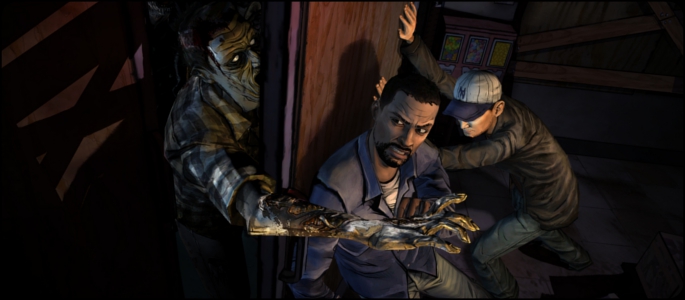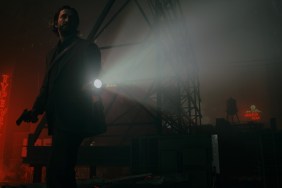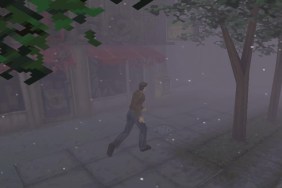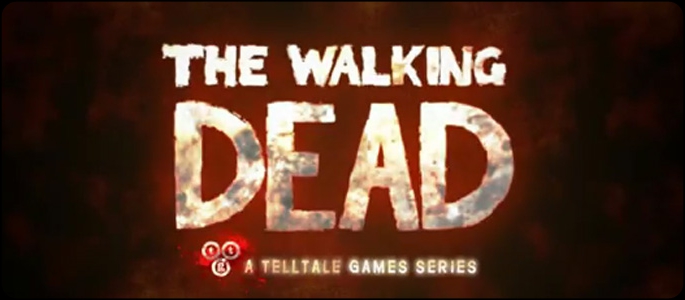
Telltale Games has had some stunning game successes including the multi-season Sam and Max series and the very well adapted Back to the Future season. But fresh in everyone’s minds is the flop that was Jurassic Park. However, JP seems to have given Telltale an adequate enough testing ground to refine some of their bigger ideas for the point-and-click adventure genre. These ideas are utilized to full effect in Telltale’s newest game The Walking Dead. I might even go so far as to say that The Walking Dead: Episode 1 – A New Day is a well made introduction to what could be one of the best Telltale adventure games of this generation.
The game opens with your character, Lee Everett, in the backseat of a cop car. He’s been convicted and sentenced to a prison term at a facility outside of the city of Atlanta. As the car speeds down the Atlanta highway, a conversation begins between you and the driver. After some Q&A and a brief tutorial, the car, for reasons that I won’t spoil, careens off the road into an embankment. Lee’s leg is injured, but he manages to escape the car and get out of his handcuffs. Unfortunately, the driver appears to have already been turned into a zombie, and Lee has no choice but to kill him. The sound of the gunshot, summons more ‘walkers’ to the area and Lee hightails it to safety, thus beginning his adventure.
Regarding the story, A New Day does a great job of really pushing pathos. The actions of the characters are shaped by your decisions, and it becomes clear early on that each decision can have enormous consequences within the context of this episode and future ones as well. Each of the characters has their own unique looks and personalities. These personalities shift and change based upon the player’s actions and dialog choices. If you choose to side with a character you will end up displeasing the one you disagreed with. Every decision seems like a double-edged sword which makes them feel more realistic and genuine. Further to this, the game also tells you when other characters pick-up on something that you’ve said or done. If you choose to trust someone or decide to hide the truth about something by using a certain phrase they’ll notice. All of these dialog moments are also timed adding to further the tension meaning that you only have a few seconds to choose what to say or, in more extreme circumstances, who to save.
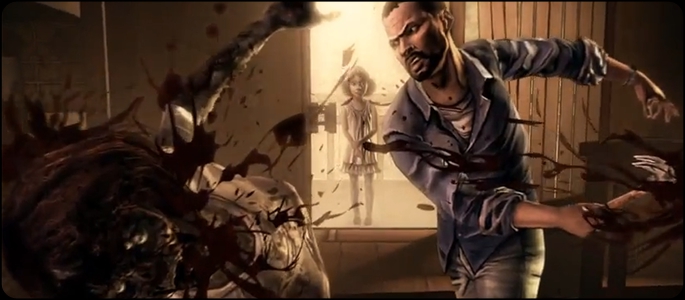
With regards to the game’s controls, the first immediately noticeable thing in TWD is how the camera controls. Unlike games like Puzzle Agent or Back to the Future, the camera is free to move around the screen without having to jump from anchor point to anchor point. In the past, the lack of a freely controllable camera has made some Telltale titles infuriating to play as the player often had to wrestle with the game in order to make a selection. Here the camera is controllable with the right stick and any objects that can be interacted with in the environment are highlighted. When the cursor is placed over the objects a series of interaction buttons appear which are mapped to the face buttons on the DualShock 3. As an example of this, in the escape from the cop car Lee has to bust open a window, but initially placing the cursor on the window only brings up a triangle button prompt allowing Lee to look at the object. Using the left stick, the player can move Lee to the window and then gain the ability to bash through it by pressing the x button. This small, but crucial change makes TWD feel more like a traditional PC based point-and-click adventure game, but also less restrictive as the player can still choose where to move around.
Inventory management has also been streamlined. Unlike Back to the Future where items had to be selected and then another object had to be interacted with, TWD automatically allows the player to use items within specific contexts. Here again these interactions are mapped to the face buttons with special items usually being mapped to either x or circle. Coupled with the controls, this makes for some very suspenseful gameplay, especially when the action is ratcheted up. Granted, the game isn’t hugely emphasizing action in order to focus more on the bleakness of the situation and the character’s roles, but one particular stealth sequence in this episode allowed you to move around from cover to cover, but you had to find a way to silently dispatch several zombies so that you could rescue one survivor. All the while you could peek out from behind cover, but staying exposed for too long would alert the zombies. It’s moments like that that make TWD fun, tense, and deeply rewarding, and show just how far Telltale has come regarding optimizing controls for consoles as opposed to PCs. The only downside to all of this is the fact that puzzles, in the normal Telltale sense, are missing from this episode. It’s a minor thing, but some hardcore Telltale fans may find the lack of actual puzzles a bit amiss.
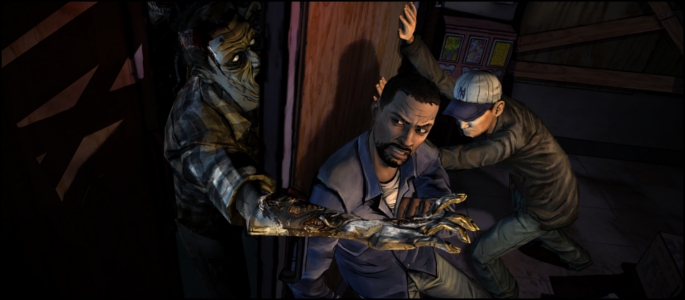
From a graphical standpoint some will simply state that it looks like every other Telltale adventure game, but the hand drawn art style very closely mimics the look of the comics upon which the game is based. There’s also a particular emphasis on dark strokes and heavy ink lines to accentuate elements of the environment and the characters themselves. Also Telltale appears to have been busy coming up with a whole slew of new facial animations to go along with the persistent nature of each of the decisions. As mentioned before, some nuances will evoke a response from a character. This is often represented in subtle facial animations that really convey what’s on an NPCs mind. Sometimes it’s as subtle as narrowing the eyes when they suspect that you aren’t being truthful, or a relaxing of the shoulders and a smirk when they realize that you agree with them. Again, this isn’t a Heavy Rain or Kara level of realism, but it breaks the mold from other game’s that Telltale has done and makes TWD that much more unique. Overall, it makes conversations with the NPCs seem much more human as opposed to the stiffness that some characters in other Telltale games have suffered from.
By the time I finished A New Day I was itching for the next episode in order to see how the decisions I had made in this one would turn out later. Even the “Next time, on The Walking Dead…” segment at the end of A New Day gives a small taste of how some of those choices will impact the next episode. Also at the end of the episode you can see what choices other players made in terms of percentages. It’s an interesting bit of information to supply to the player and, in my case, had me second guessing some moves I made. Did I choose to save someone because they’re a good shot and may prove useful later? Why have I chosen to protect Clementine instead of being a real dick? Should I ignore the horror movie enthusiast in me and travel by night? Also, a small thing that unburdens the player from worrying about their decisions, is that the trophies within the game are all progression based (there’s also a platinum trophy in case anyone was wondering). None of them is for finding special objects or doing something extraordinary. Indeed, the main message of A New Day is make your choices, but be prepared for the consequences. Having made my decisions, I’m eager to see what new options I’ll be presented with and what consequences I’ll have to live with.
PlayStation LifeStyle’s Final Score
+ The game has you making choices that feel like they actually matter in the long run. + Streamlined and more precise controls. – Traditional Telltale puzzles are strangely absent. |
 |
–
